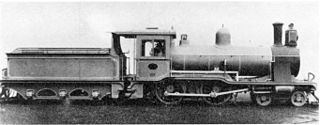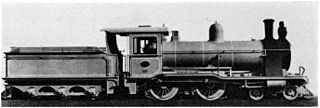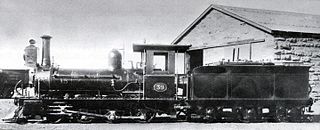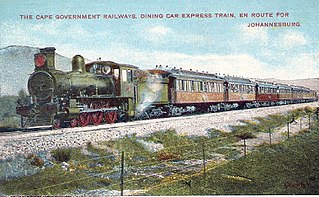
The Cape Government Railways 3rd Class locomotives include seven locomotive types, all designated 3rd Class irrespective of differences in wheel arrangement or configuration.
When the Union of South Africa was established on 31 May 1910, the three Colonial government railways (Cape Government Railways, Natal Government Railways and Central South African Railways) were united under a single administration to control and administer the railways, ports and harbours of the Union. Those of these locomotives which still survived, were considered obsolete and designated Class 03 on the new South African Railways. [1]

The Union of South Africa is the historical predecessor to the present-day Republic of South Africa. It came into being on 31 May 1910 with the unification of the Cape Colony, the Natal Colony, the Transvaal, and the Orange River Colony. It included the territories that were formerly a part of the South African Republic and the Orange Free State.
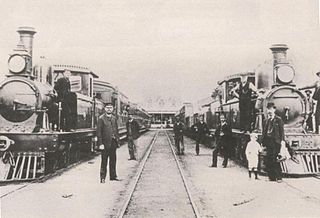
The Cape Government Railways (CGR) was the government-owned railway operator in the Cape Colony from 1874 until the creation of the South African Railways (SAR) in 1910.

The Natal Government Railways (NGR) was formed in January 1877 in the Colony of Natal.
- 2-6-0 wheel arrangement
- CGR 3rd Class 2-6-0T (Tank)
- 4-4-0 wheel arrangement
- CGR 3rd Class 4-4-0 1883 (Tender)
- CGR 3rd Class 4-4-0 1884 (Tender, experimental)
- CGR 3rd Class 4-4-0 1889 (Tender)
- CGR 3rd Class 4-4-0 1898 (Tender)
- CGR 3rd Class 4-4-0 1901 (Tender)
- CGR 3rd Class 4-4-0 1903 (Tender)

The Cape Government Railways 3rd Class 4-4-0 of 1883 was a South African steam locomotive from the pre-Union era in the Cape of Good Hope.

The Cape Government Railways 3rd Class 4-4-0 of 1884 was a South African steam locomotive from the pre-Union era in the Cape of Good Hope.

The Cape Government Railways 3rd Class 4-4-0 of 1889 was a South African steam locomotive from the pre-Union era in the Cape of Good Hope.









